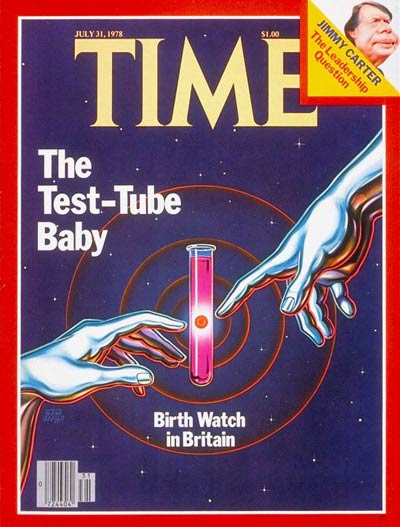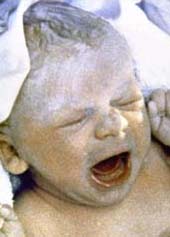

SPRING QUARTER, 2006
Department of History
University of California, Irvine
Instructor: Dr. Barbara J. Becker
|
Lecture 18. Artificial Man
|
|
|
| 1677 | Anton von Leeuwenhoek (1632-1723) observed "animalcules" under a microscope | ||||||||||||
| 1694 | Homunculus drawn by Nicholas Hartsoeker (1656-1725) | ||||||||||||
| 1784 | Lazzaro Spallanzani (1729-1799) artificially inseminated a dog which gave birth to 3 healthy pups 62 days later. | ||||||||||||
| 1785 | child born following the first attempts at artificial insemination on a human subject by Scottish surgeon, John Hunter (1728-1793) | ||||||||||||
| 1827 | Karl Ernst von Baer (1792-1876) identified the mammalian ovum; like many of his predecessors, he regarded sperm cells as parasites; named them "spermatozoa" | ||||||||||||
| 1856 | "January 1, A.D. 3000" published in Harper's New Monthly Magazine, vol. 12 | ||||||||||||
excerpts from
..."My friend the learned Professor John Pierre Selinghuysen, has invented a plan whereby one portion of the body may be developed to the exclusion of the others. For instance, you bring him a man who is to be a blacksmith. He puts him through a course of treatment which forces all his vital energy into his arms and chest: his legs shrivel up, his head becomes a mere appendage, but his arms and chest are those of a Hercules. Give him a danseuse. In six months her nether extremities will have acquired the strength of iron with the elasticity of India rubber; true, her arms and bust will have dwindled away, but she doesn't need them. For her speciality legs are the thing needful; and therein she is unapproachable. Ah! my good Sir, civilization has made great strides of late years." I acknowledged the fact, and gloomily thought what sort of a world this would be, if we all followed the speciality system, and each person reduced himself to be the mere bearer of a single organ. "Of course you are aware," said he, "that though we have not yet succeeded in finding the proportions of albumen and carbon requisite for the manufacture of a perfect man, we have been very successful with detached members and limbs. It is quite common, nowadays, for a man to have a spare leg or arm at home; and a fellow would be ashamed of wearing the nose nature gave him, if it resembled some of those we see in the old statues."
"Every thing nowadays," continued my guide, "is done in pursuance of a system. We have constantly the best men in the republic at work in search for the best mode of doing whatever has to be done. When they discover that best mode, a law is immediately passed to declare it the only mode, and all others are prohibited under heavy penalties. For instance, in former times the education of children was left to chance and to the caprice of their parents, whence it constantly happened that promising natures were ruined. Now, step in here. This is our Educational Establishment. The day after a child is born he is brought here, and intrusted to the charge of the distributor of infantine nourishment. This is the Infantine Ward, one of the best in the building."
We had entered a large room, on either side of which stood cases such as were used in my time in stores for the reception of goods. Each case was provided with a small mattress and a blanket. Along the front of the cases ran a tube like a gaspipe, and from it shorter tubes, terminating in funnel-shaped mouth-pieces, stretched into each case. The deafening sound which assailed my ear when we entered quite prepared me to discover that almost all the cases were inhabited. A stout man received us with a rough sort of politeness, and in answer to a question from my companion, said that the supply was slack at this season, not over a couple of hundred arrivals per day. I asked where the mothers were. "Mothers? ah! I forgot. I have read of the old-fashioned maternal duties. They must have been a dreadful bore. We did away with them long ago. Children are reared in this establishment from their birth on a substance called supra-lacto-gune. It is composed of 15 parts of gelatin, 25 of gluten, 20 of sugar, and 40 of water, and is certified by the government chemists to be the very best article of nutrition possible. What is the average mortality now, Abdallah?" The stout man said briefly: "Fifty-seven and a quarter per cent." "Think of that!" exclaimed my guide triumphantly; "my friend, Doctor Belphegor, assures me that in former times the mortality among babies was never less than eighty and often a hundred per cent." I said, deferentially, that though the new plan was doubtless far preferable to the old one, the children did not appear to like it, judging from their cries. "Oh! mere play! mere amusement! We like babies to cry. Out of a hundred children who don't cry, we find that exactly eighty-four and three-quarters die under six months; whereas your thorough roarers seldom fail. At fifteen months the babies are removed from this room and pass their examination before the State Phrenological Commission. Their heads are thoroughly examined, their mental capacities recorded, and their vocation in life decided. On leaving the Commissioners' room, each infant has a ticket pasted on its person, bearing the name of the trade or profession to which it is destined. Those who are to be mechanics go through a course of training to prepare them for their apprenticeship, and are then shipped to the country which is appropriate to the industry of which they are to be acolytes. Those, on the contrary, whose phrenological development justifies the Commissioners in setting them apart to be lawyers, doctors, clergymen, or men of letters, are sent to the Grand College of Peerless. This is, we flatter ourselves, the greatest establishment of the kind ever known....
"[B]by a recent special act, parents who are ambitious of early distinction for their children are allowed to send them to private academies on the plan of hot-houses. The youths who are thus reared are placed under cover in a peculiar atmosphere, calculated to hasten the development of the brain. All that the teacher has to do is to keep the thermometer up to a certain point. In this way, children have been produced who calculated eclipses before they could speak, and cut out plans of fortifications in clay before cutting their teeth...."
|
|||||||||||||
| 1866 | American gynecologist, Marion Sims (1813-1883), performed 55 artificial inseminations on 6 women with cervical abnormalities; one pregnancy occurred | ||||||||||||
1883
|
Infant could be accessed through door (P). Infant could be viewed through movable glass cover (d). Space (K) filled with sawdust to insulate the cubicle. Heater (Th) raised water (W) temperature. Ventilating air (L) was warmed as it flowed around water reservoir before entering infant cubicle. |
||||||||||||
| 1884 | William Pancoast of Philadelphia performed the first confirmed artificial insemination using donor sperm; while under anesthesia, the wife of one of Pancoast's patients was successfully impregnated before an audience of medical students using semen obtained from "the best-looking member of the class" | ||||||||||||
| 1897 | British biologist Walter Heape (1855-1929) recovered rabbit embryo after flushing oviduct; transferred it to foster-mother, in which normal development continued; work encouraged others to look at possibility of culturing embryos in the laboratory | ||||||||||||
| 1898 |
Premature infants in mechanical incubators on display at the Trans-Mississippi Exposition in Omaha, Nebraska |
||||||||||||
| 1901 |
Incubators and their premature occupants on display at the Pan-American Exposition in Buffalo, New York |
||||||||||||
| 1904 |
Nurse tending to a premature baby on display at the Louisiana Purchase Exposition at St. Louis |
||||||||||||
| 1923 | J.B.S. Haldane published "DÆDALUS, or Science and the Future" | ||||||||||||
| 1932 | Aldous Huxley published Brave New World | ||||||||||||
| 1948 | First successful internal heart surgery performed | ||||||||||||
| 1952 | First successful sex-change operation Amniocentesis allowed fetus to be checked for abnormalities |
||||||||||||
| 1953 | Open-heart surgery performed with the aid of a heart-lung machine Structure of DNA described |
||||||||||||
| 1954 | First kidney transplant performed on an identical twin | ||||||||||||
| 1955 | Ultrasound introduced in obstetrics | ||||||||||||
| 1960 | Pacemaker for the heart developed Oral contraceptive introduced |
||||||||||||
| 1962 | First artificial hip operation | ||||||||||||
| 1963 | First liver transplant performed | ||||||||||||
| 1967 | A whole heart transplanted from one human to another Coronary bypass operation performed Mammography introduced |
||||||||||||
| 1968 | New fertility drugs caused British woman to give birth to sextuplets Epidural anesthetic technique, to ease pain in childbirth, announced |
||||||||||||
| 1969 | Single gene isolated for first time | ||||||||||||
| 1970 | First successful nerve transplant | ||||||||||||
| 1971 | Fiber-optic endoscope developed for looking inside the human body | ||||||||||||
| 1972 | CAT (computerised axial tomography) scanning for cross-sectional X-rays of human body | ||||||||||||
| 1973 | Recombinant DNA technique developed -- start of genetic engineering First NMR (nuclear magnetic resonance) image taken |
||||||||||||
| 1978 | Insulin 'manufactured' in bacteria from synthetic DNA First 'test tube' baby born |
||||||||||||

|

Louise Brown
Over 35,000 IVF infants born in 2000 Over 1.5 million IVF infants born since 1978 |
| 1981 | Embryonic stem cells first isolated in mice |
| 1982 | Artificial heart transplanted into a patient -- survived 112 days |
| 1984 | Infant given baboon heart transplant -- survived 20 days |
| 1986 | First heart, lung, and liver transplant |
| 1987 | First successful five-organ transplant Entire human knee transplanted |
| 1988 | RU486 marketed |
| 1990 | First surgery on a baby in its mother's womb Human Genome Project begun |
| 1995 | Embryonic stem cells first isolated in primates |
| 1996 | First mammal cloned -- Dolly, the sheep |
| 1998 | First human embryonic stem cells isolated using tissue from two sources: - tissue of aborted fetuses - embryos gathered for in vitro fertilization |
| 2001 | First self-contained mechanical heart implanted Limitations placed on funding for stem cell research Researchers claim to have cloned first human embryo -- results questioned |
| 2003 | Death of first cloned mammal Human Genome Project completed |
| 2004 | Hwang Woo Suk announces successful cloning of human embryo for use as non-controversial stem cell source |
| 2005 | In May, Hwang announced streamlined cloning procedure In November, Hwang's discoveries found to have been based on false claims |
With a little marketing . . . traditional reproduction may begin to seem antiquated, if not downright irresponsible. One day, people may view sex as essentially recreational, and conception as something best done in the laboratory.
--Gregory Stock (Redesigning Humans, 2002)

|